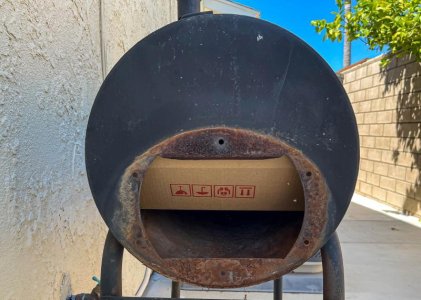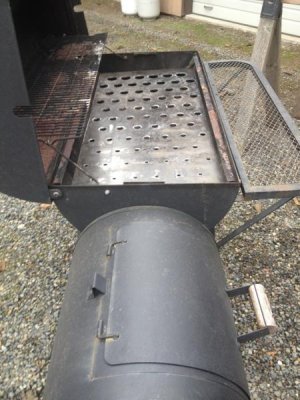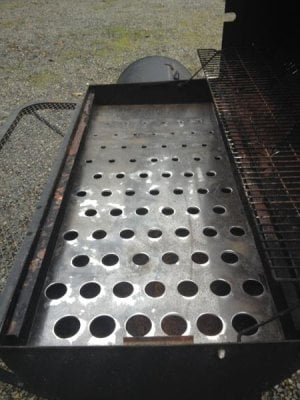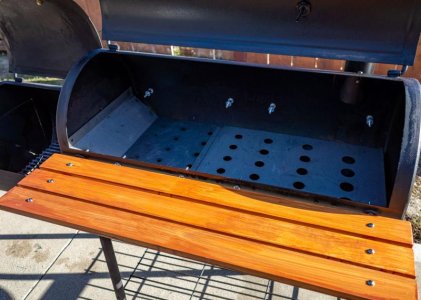I have a New Braunfels smoker I’m trying to restore. I’d like to add a tuning/baffle plate to control the heat on this smoker and found a baffle by Lavalock that’s 14.5” (depth). The site selling this baffle suggests using a baffle plate that’s approximately 2” smaller in depth than the depth of the smoker at grill level. I measured the depth of the NB, and it’s 16” so this plate would be about right according to their recommendation. I made a mockup of the plate in cardboard to see how it fits. The picture below shows how it will sit in the smoker. Although you can’t really tell, the cardboard is coming up at a 45-degree angle where it contacts the smoker wall near the opening. Does this look like it sits a little too low in the smoker? Should I look for something maybe around 15” that would sit higher? I have ZERO experience with offset smokers, so any advice is appreciated.
You are using an out of date browser. It may not display this or other websites correctly.
You should upgrade or use an alternative browser.
You should upgrade or use an alternative browser.
Questions about baffle plate for offset smoker
- Thread starter JCBII
- Start date
Looks like it is close enough to try. Surely this has been discussed around here. You might try searching for posts on this subject.
Thanks oldgfbbq, I think I'll go with the baffle from lavalock. And I do need to remember to use the search function. I've used it a lot for other topics, for forgot about it on this one.
Bob O Q Shawtee
Knows what a fatty is.
- Joined
- Oct 9, 2013
- Location
- North Texas
I've been messing with plates and dampers for a few years and never saw one fitted like the one in your picture. What I settled on for the NB like yours was plates that lay below and on same plane as grates. I don't recall length but when in place there was about a 1.5" opening from fire box above the plate so I blocked it with a small metal strip bolted in place,forcing air,heat and smoke beneath plate(s) in meat box. I added a stack that when all plates were in place and origional stack blocked,I effectivly had a reverse flow. I most often used 1 plate and blocked optional. My goal (never accomplished) was to extend time between need for adding wood.
Lynn Dollar
is Blowin Smoke!
The Old Country Brazos and Pecos comes with a baffle and a large number of people are cutting them out.
I had one in my Brazos that I never cut out but should have.
And on second thought, I need to edit this .......... I don't know where you plan on having your exhaust exit. If its at the top, you might be better served with a baffle.
The Old Country pits exit at grate level. With a baffle, the heat runs under the cooking grate and out the cooker.
The old Okie Joes and the current Yoder/Horizon pits exit at the top and use a baffle/convection plate.
I had one in my Brazos that I never cut out but should have.
And on second thought, I need to edit this .......... I don't know where you plan on having your exhaust exit. If its at the top, you might be better served with a baffle.
The Old Country pits exit at grate level. With a baffle, the heat runs under the cooking grate and out the cooker.
The old Okie Joes and the current Yoder/Horizon pits exit at the top and use a baffle/convection plate.
Last edited:
sandro
Full Fledged Farker
Do without, leave it open. Downward deflectors cause a nuclear hot spot in the middle of the cooking grate
Lynn Dollar
is Blowin Smoke!
Do without, leave it open. Downward deflectors cause a nuclear hot spot in the middle of the cooking grate
As I've said, not if it exhausts out the top. Its then a bottom up cooker.
sandro
Full Fledged Farker
As I've said, not if it exhausts out the top. Its then a bottom up cooker.
Mine has the stack on top, used to have a downward lip at the throat, huge hot spot in the middle of the cooking grate which only got worse as draw increased; took it out, perfect cooks every time
Lynn Dollar
is Blowin Smoke!
That's why Yoder and Horizon put convection plates in their bottom up smokers.
sandro
Full Fledged Farker
That's why Yoder and Horizon put convection plates in their bottom up smokers.
Fair enough but who wants a bottom-up smoker
- Joined
- Jan 3, 2014
- Location
- Detroit...
Mine has the stack on top, used to have a downward lip at the throat, huge hot spot in the middle of the cooking grate which only got worse as draw increased; took it out, perfect cooks every time
this was my experience with my cheap offset. I settled on a small flat baffle at the firebox. still had a hot spot...the first 3rd of the pit just ran too hot
sandro
Full Fledged Farker
this was my experience with my cheap offset. I settled on a small flat baffle at the firebox. still had a hot spot...the first 3rd of the pit just ran too hot
I fabricated a Millscale / Franklin style deflector that sits 2" above the throat, it concentrates the hot spot in the last 8-10" or so, most of the cooking grate holds steady at the same temp. Fair to say that downward baffles are meant for bottom-up cookers but I get the best results cooking top-down
SmokinEdge
Knows what a fatty is.
I have modified a NB offset with tuning plates that effectively block the heat, I also lowered the firebox and installed a plenum style exhaust. Works pretty well now.
Kevin James
Full Fledged Farker
Before you do anything, you need to ask yourself a couple key questions. Especially since you say yourself you have zero experience with offset cookers. Personally, I learned the hard way... for me it was buy once, cry twice and buy again LOL. So... let me try to save you the trouble (and possibly money).
1. What do you like to cook and how do you like to cook it? What this really boils down to is the age old question.... fat cap up or fat cap down?
2. What type of cooker will give you better results based on your answer to question number 1? If you like fat cap up, you want a top down cooker, if you like fat cap down, you want a bottom up cooker.
Example: I'm all about Texas style BBQ, and especially brisket which they traditionally cook fat cap up. Even my pork butts, I like fat cap up. That said, a top down cooker will give me the best results for my style of cooking.
Next, you need to understand the different types of offsets and how the heat flows in them.
1. A traditional flow "open pit" design has no baffle at the throat opening between the fire box and cook chamber, and does not use tuning plates of any kind. This will be a top down cooker, as the heat comes up out of the throat and goes over the top of the food. Fat cap up works best in this type of cooker. This is what your NB smoker is as stock. The Oklahoma Joe Highland/Long Horn is another inexpensive example of this type.
2. A Traditional flow with a downward baffle at the throat (as what you are looking at) will be a bottom up cooker, as the heat is directed down by the baffle and is deflected to the center of the cook chamber where it rises. This may or may not cause a hot spot in the center of your cook chamber. Fat cap down works best in this type of cooker. The Old Country Pecos/Brazos, and the Workhorse Pits 1957/1969/1975 are examples of this style.
3. A traditional flow with a downward baffle and tuning plates will also be a bottom up cooker. The baffle directs the heat down, and it flows under the tuning plates, coming up from the spaces between the plates (or in some cases the holes in a one piece tuning plate). Fat cap down also works best in this type of cooker. The Lone Star Grillz cookers are examples of this style.
4. A reverse flow has a solid baffle that runs from the firebox side to the other end. The heat and smoke run under the baffle to the other side where it enters the cook chamber and moves over the food. This type of cooker is kind of a hybrid, because you have convective heat flowing top down over the food, but you have a significant amount of radiant heat coming up from the reverse flow plate hitting the bottom of the food. Fat cap down works best in this type of cooker because of the strong radiant heat directly under the food from the reverse flow plate. Shirley Fabrication and Lang are examples of this style cooker.
Figure out how you like to cook, and you will figure out what type of cooker will work best for you, which will then answer your question on if that baffle will be a good idea for you, or a bad idea.
When I bought my first offset I screwed up because I did not really understand any of what I describe above. I bought a reverse flow cooker which I later realized is a bottom up cooker best suited for fat cap down..... but I prefer to cook brisket and pork butts fat cap up. The pork butts were a little crispy on the bottom but still turned out OK since they were shredded anyways, but my briskets just never really turned out right.
I now have a traditional flow open pit (Big Phil's Blue Smoke Smoker), which is a top down cooker and my briskets and shoulders come out amazing. Mine has a removable Mill Scale/Franklin type baffle which technically means I have added a baffle (although I can take it out any time), but this style baffle still causes the heat and smoke to flow up over the food, so still a top down cooker. Below is a picture of this type of baffle (not mine, this is actually member TheHojo's, but mine is identical). This is also the same baffle concept mentioned earlier in this thread by member Sandro.
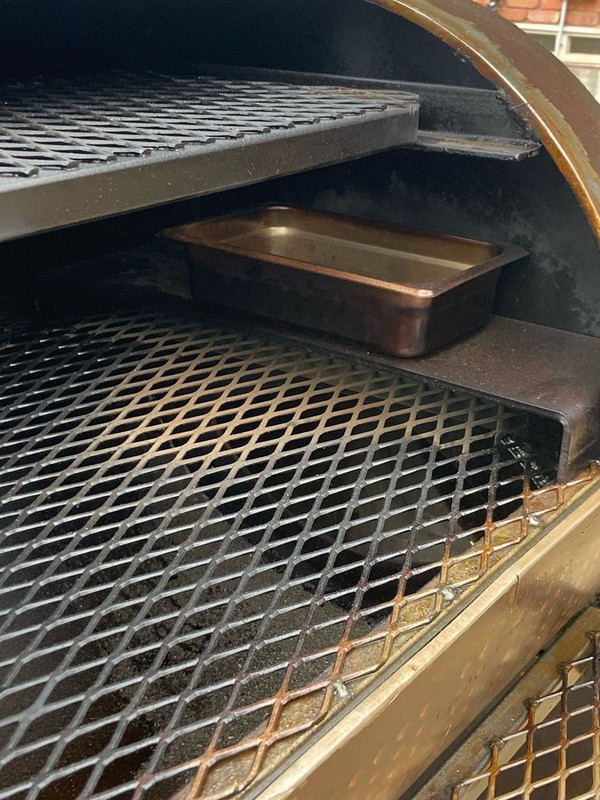
Moral of the story... knowing what you like to cook and how you like to cook it, and having the right type of cooker to cook that way and work WITH you instead of against you makes all the difference in the world.
1. What do you like to cook and how do you like to cook it? What this really boils down to is the age old question.... fat cap up or fat cap down?
2. What type of cooker will give you better results based on your answer to question number 1? If you like fat cap up, you want a top down cooker, if you like fat cap down, you want a bottom up cooker.
Example: I'm all about Texas style BBQ, and especially brisket which they traditionally cook fat cap up. Even my pork butts, I like fat cap up. That said, a top down cooker will give me the best results for my style of cooking.
Next, you need to understand the different types of offsets and how the heat flows in them.
1. A traditional flow "open pit" design has no baffle at the throat opening between the fire box and cook chamber, and does not use tuning plates of any kind. This will be a top down cooker, as the heat comes up out of the throat and goes over the top of the food. Fat cap up works best in this type of cooker. This is what your NB smoker is as stock. The Oklahoma Joe Highland/Long Horn is another inexpensive example of this type.
2. A Traditional flow with a downward baffle at the throat (as what you are looking at) will be a bottom up cooker, as the heat is directed down by the baffle and is deflected to the center of the cook chamber where it rises. This may or may not cause a hot spot in the center of your cook chamber. Fat cap down works best in this type of cooker. The Old Country Pecos/Brazos, and the Workhorse Pits 1957/1969/1975 are examples of this style.
3. A traditional flow with a downward baffle and tuning plates will also be a bottom up cooker. The baffle directs the heat down, and it flows under the tuning plates, coming up from the spaces between the plates (or in some cases the holes in a one piece tuning plate). Fat cap down also works best in this type of cooker. The Lone Star Grillz cookers are examples of this style.
4. A reverse flow has a solid baffle that runs from the firebox side to the other end. The heat and smoke run under the baffle to the other side where it enters the cook chamber and moves over the food. This type of cooker is kind of a hybrid, because you have convective heat flowing top down over the food, but you have a significant amount of radiant heat coming up from the reverse flow plate hitting the bottom of the food. Fat cap down works best in this type of cooker because of the strong radiant heat directly under the food from the reverse flow plate. Shirley Fabrication and Lang are examples of this style cooker.
Figure out how you like to cook, and you will figure out what type of cooker will work best for you, which will then answer your question on if that baffle will be a good idea for you, or a bad idea.
When I bought my first offset I screwed up because I did not really understand any of what I describe above. I bought a reverse flow cooker which I later realized is a bottom up cooker best suited for fat cap down..... but I prefer to cook brisket and pork butts fat cap up. The pork butts were a little crispy on the bottom but still turned out OK since they were shredded anyways, but my briskets just never really turned out right.
I now have a traditional flow open pit (Big Phil's Blue Smoke Smoker), which is a top down cooker and my briskets and shoulders come out amazing. Mine has a removable Mill Scale/Franklin type baffle which technically means I have added a baffle (although I can take it out any time), but this style baffle still causes the heat and smoke to flow up over the food, so still a top down cooker. Below is a picture of this type of baffle (not mine, this is actually member TheHojo's, but mine is identical). This is also the same baffle concept mentioned earlier in this thread by member Sandro.

Moral of the story... knowing what you like to cook and how you like to cook it, and having the right type of cooker to cook that way and work WITH you instead of against you makes all the difference in the world.
Last edited:
larry4406
Full Fledged Farker
JCBII - what did you ultimately decide to do?
I have a near identical New Braunfels and have been contemplating the LavaLock 37x14.5 which I am guessing is the one you were thinking about.
https://bbqsmokermods.com/lavalockr-37-x-14-5-baffle-plate-horizontal-bbq-smoker-tuning-system.html
Kevin James - very informative, thank you. I don't quite understand the baffle you are showing. Under the lower grate, the firebox still appears quite open. Is the support for the water tray the baffle you are referring to?
I have a near identical New Braunfels and have been contemplating the LavaLock 37x14.5 which I am guessing is the one you were thinking about.
https://bbqsmokermods.com/lavalockr-37-x-14-5-baffle-plate-horizontal-bbq-smoker-tuning-system.html
Kevin James - very informative, thank you. I don't quite understand the baffle you are showing. Under the lower grate, the firebox still appears quite open. Is the support for the water tray the baffle you are referring to?
JCBII - what did you ultimately decide to do?
I have a near identical New Braunfels and have been contemplating the LavaLock 37x14.5 which I am guessing is the one you were thinking about.
https://bbqsmokermods.com/lavalockr-37-x-14-5-baffle-plate-horizontal-bbq-smoker-tuning-system.html
Kevin James - very informative, thank you. I don't quite understand the baffle you are showing. Under the lower grate, the firebox still appears quite open. Is the support for the water tray the baffle you are referring to?
Yes - this is the baffle that Kevin referenced (thanks for the shout out Kevin) - 1/4 inch thick plate that can be removed if not needed - so an above the grate baffle


Kevin James
Full Fledged Farker
To add some additional color, the baffle Hojo and I are referencing is the same concept used by Mill Scale in their 94 Gallon, and also the Franklin offset. It helps to move the hot spot back towards the firebox. I'm not exactly sure how it accomplishes that, but since it is removable I have tested with and without, and I just know it works.
JCBII - what did you ultimately decide to do?
I have a near identical New Braunfels and have been contemplating the LavaLock 37x14.5 which I am guessing is the one you were thinking about.
https://bbqsmokermods.com/lavalockr-37-x-14-5-baffle-plate-horizontal-bbq-smoker-tuning-system.html
Kevin James - very informative, thank you. I don't quite understand the baffle you are showing. Under the lower grate, the firebox still appears quite open. Is the support for the water tray the baffle you are referring to?
I ended up restoring the New Braunfels smoker and added the Lavalock baffle that you have listed. I've smoked two pork butts and two turkeys with it so far and they were great. As soon as it stops raining around here, I plan to smoke a 9lb pork butt for my neighbors.
Based on Kevin's post (thanks Kevin for all the good info!!), it's now a bottom-up smoker but the heat distribution seems to be even throughout. The only spot that seems to be a little hotter than the rest is the back side of the smoker right about in the middle of the grates. The way I discovered this was when I probed the first turkey I smoked, the side facing the back of the grill was 162 degrees and the side facing the front was 157 degrees (which is where I originally had the temp probe inserted). For subsequent cooks, I now rotate the meat a few times to keep the meat temps even throughout the cook.
Btw, that Lavalock is too long for this smoker, but it's no problem at all. I just let it overlap a little and it's actually easier to remove as two pieces when I need to clean it.
Attachments
Similar threads
- Replies
- 23
- Views
- 1K



